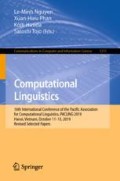Abstract
Despite the success of recent rap and poetry generations using neural models, many of them do not consider vowels of the entire lyrics. Also, in many cases it is virtually impossible to generate completely new lyrics, because only existing rap lyrics are used as data sets. This paper proposes a new method of rap lyrics generation using a large amount of text such as novels in addition to rap lyrics. We divided the generation of rap lyrics into two steps; first, Generative Adversalial Net (GAN) generates rhymes and flows. Second, sequence-to-sequence converts them into rap lyrics. In addition, this method refers to the generation style of rap songs. In other words, they determine the music and rhythm first and apply the words second. We evaluated our method based on BLEU that can be measured mechanically.
Access this chapter
Tax calculation will be finalised at checkout
Purchases are for personal use only
References
Ghazvininejad, M., Shi, X., Choi, Y., Knight, K.: Generating topical poetry. In: Proceedings of the 2016 Conference on Empirical Methods in Natural Language Processing, pp. 1183–1191 (2016)
Lau, H.J., Cohn, T., Baldwin, T., Brooke, J., Hammond, A.: Deep-speare: a joint neural model of poetic language, meter and rhyme. In: Proceedings of the 56th Annual Meeting of the Association for Computational Linguistics (ACL 2018) (2018)
Gervás, P.: WASP: evaluation of different strategies for the automatic generation of Spanish verse. In: Proceedings of the AISB 2000 Symposium on Creative & Cultural Aspects of AI, pp. 93–100 (2000)
Oliveira, H.: Automatic generation of poetry: an overview. In: Proceedings of 1st Seminar of Art, Music, Creativity and Artificial Intelligence (2009)
Oliveira, H.: PoeTryMe: a versatile platform for poetry generation. In: Computational Creativity, Concept Invention, and General Intelligence, vol. 1 (2012)
Agirrezabal, M., Arrieta, B., Astigarraga, A., Hulden, M.: POS-tag based poetry generation with WordNet. In: Proceedings of the 14th European Workshop on Natural Language Generation, pp. 162–166 (2013)
Greene, E., Bodrumlu, T., Knight, K.: Automatic analysis of rhythmic poetry with applications to generation and translation. In: Proceedings of the 2010 Conference on Empirical Methods in Natural Language Processing, pp. 524–533 (2010)
Yan, R.: i, Poet: automatic poetry composition through recurrent neural networks with iterative polishing schema. In: IJCAI, pp. 2238–2244 (2016)
Yu, L., Zhang, W., Wang, J., Yu, Y.: SeqGAN: sequence generative adversarial nets with policy gradient. In: 31st AAAI Conference on Artificial Intelligence (2017)
Zhou, M., Jiang, L., He, J.: Generating Chinese couplets and quatrain using a statistical approach. In: Proceedings of the 23rd Pacific Asia Conference on Language, Information and Computation, vol. 1 (2009)
Yi, X., Li, R., Sun, M.: Generating Chinese classical poems with RNN encoder-decoder. In: Sun, M., Wang, X., Chang, B., Xiong, D. (eds.) CCL/NLP-NABD -2017. LNCS (LNAI), vol. 10565, pp. 211–223. Springer, Cham (2017). https://doi.org/10.1007/978-3-319-69005-6_18
Malmi, E., Takala, P., Toivonen, H., Raiko, T., Gionis, A.: DopeLearning: a computational approach to rap lyrics generation. In: Proceedings of the 22nd ACM SIGKDD International Conference on Knowledge Discovery and Data Mining, pp. 195–204. ACM (2016)
Wu. D., Addanki, K.: Learning to rap battle with bilingual recursive neural networks. In: 24th International Joint Conference on Artificial Intelligence (2015)
Author information
Authors and Affiliations
Corresponding author
Editor information
Editors and Affiliations
Rights and permissions
Copyright information
© 2020 Springer Nature Singapore Pte Ltd.
About this paper
Cite this paper
Miyano, T., Saito, H. (2020). Rap Lyrics Generation Using Vowel GAN. In: Nguyen, LM., Phan, XH., Hasida, K., Tojo, S. (eds) Computational Linguistics. PACLING 2019. Communications in Computer and Information Science, vol 1215. Springer, Singapore. https://doi.org/10.1007/978-981-15-6168-9_26
Download citation
DOI: https://doi.org/10.1007/978-981-15-6168-9_26
Published:
Publisher Name: Springer, Singapore
Print ISBN: 978-981-15-6167-2
Online ISBN: 978-981-15-6168-9
eBook Packages: Computer ScienceComputer Science (R0)

